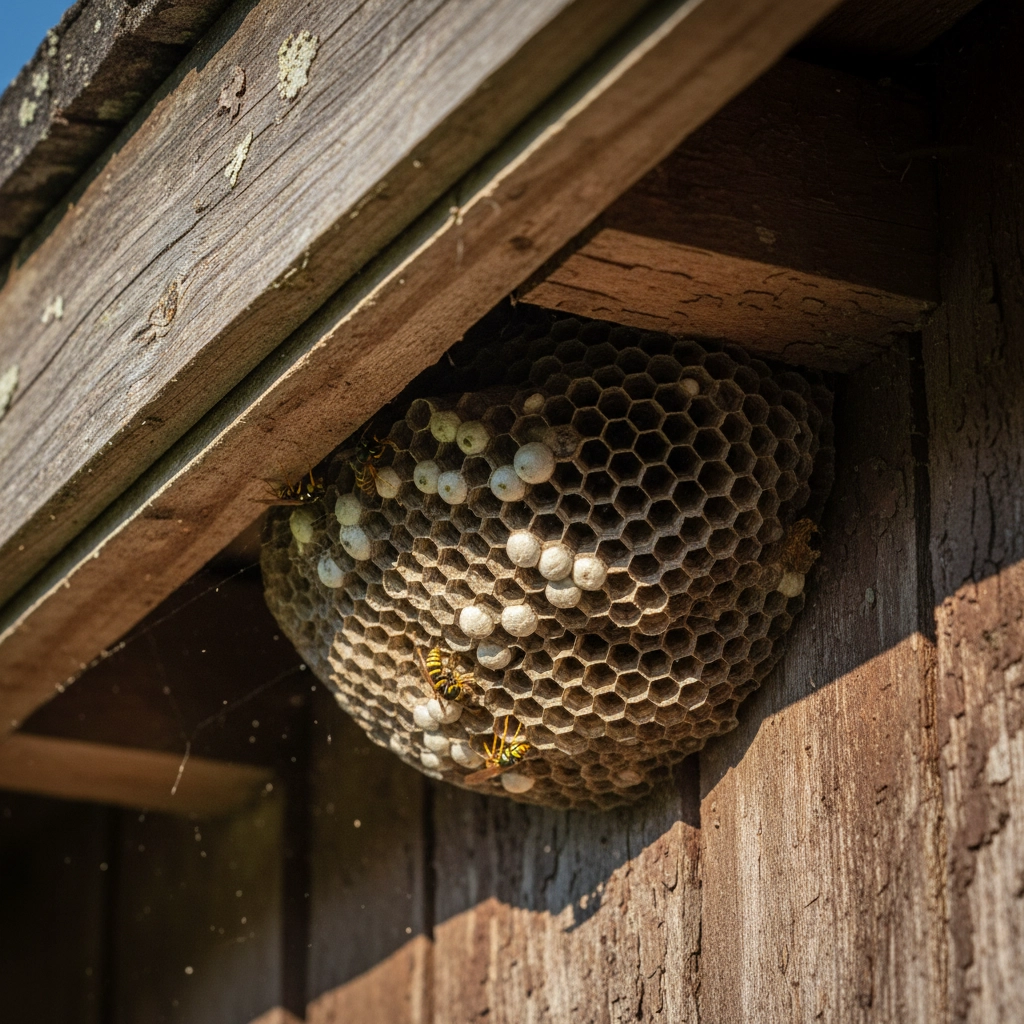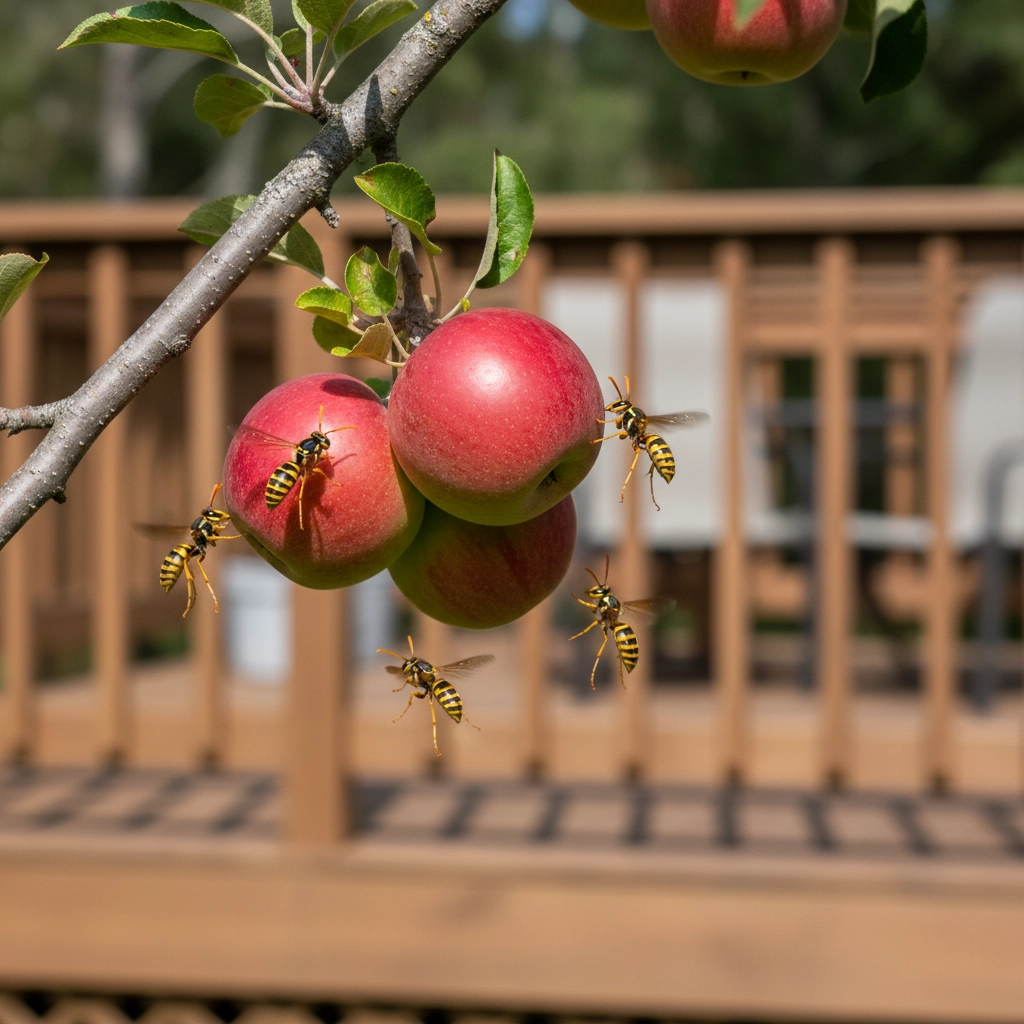Why Are There So Many Wasps Around My Home With No Visible Nest?
- Targeted Wildlife and Pest Solutions

- Sep 27
- 5 min read
You step outside to enjoy your Haliburton County property, and there they are: wasps buzzing around your deck, hovering near your garden, or circling your outdoor dining area. You look around for a nest but can't find one anywhere. This puzzling situation leaves many property owners wondering: where are all these wasps coming from?
The presence of numerous wasps without a visible nest is actually quite common, especially in cottage country like Haliburton. Understanding wasp behavior and the unique characteristics of our region can help explain this phenomenon and guide you toward effective solutions.
Hidden Nests: The Most Likely Culprit
The primary reason you're seeing wasps without spotting their nest is simple: you haven't found their well-concealed home yet. Wasps are master architects when it comes to choosing nest locations that offer protection from predators, weather, and human interference.

In Haliburton County's diverse landscape, wasps exploit numerous hiding spots that property owners often overlook:
Underground Locations: Yellow jackets frequently build subterranean nests in old rodent burrows, under tree roots, or in soft soil areas around your property. These ground nests can be nearly impossible to spot until you accidentally step close to the entrance.
Structural Voids: Your cottage or home offers countless hidden spaces. Wasps commonly nest inside wall cavities, under roof eaves, in attic spaces, behind siding, or within the gaps of decking. These locations provide excellent insulation and protection.
Natural Concealment: Dense vegetation, hollow trees, woodpiles, and brush piles create perfect nesting opportunities. The thick forests and natural landscapes common in Haliburton provide abundant natural hiding spots.
Outbuilding Spaces: Sheds, garages, boathouses, and other structures on your property offer numerous secluded corners, overhangs, and storage areas where wasps can establish colonies unnoticed.
Foraging Behavior: Your Property as a Food Source
Even when there's no nest on your immediate property, wasps can travel significant distances: sometimes over a mile: to find food and water. Your Haliburton property might simply be an attractive foraging destination.
Wasps are opportunistic feeders with diverse dietary needs throughout their lifecycle. Early in the season, they focus primarily on protein sources to feed their developing larvae. Later in summer and fall, adult wasps shift toward sugary substances for energy.
Protein Attractions: Wasps actively hunt other insects around your property. A healthy ecosystem with abundant flies, caterpillars, aphids, and other small insects creates an all-you-can-eat buffet for foraging wasps. Your garden's pest population inadvertently supports wasp activity.
Sweet Temptations: Ripe fruit from apple trees, fallen berries, flowering plants, and outdoor dining areas provide the sugary calories adult wasps crave. Even small amounts of sweet residue on outdoor furniture or barbecue equipment can draw them in.
Water Sources: Wasps need water for nest construction and cooling. Swimming pools, hot tubs, pet water bowls, irrigation systems, or any standing water around your property creates an attractive resource.
Seasonal Patterns in Haliburton County
Ontario's climate creates distinct wasp activity patterns that explain why you might suddenly notice increased wasp presence without finding nests.
Spring Emergence: Queen wasps emerge from winter hibernation in April and May, searching for suitable nesting sites. During this period, you'll see individual wasps exploring your property as they evaluate potential locations.
Summer Peak Activity: July and August represent peak wasp activity when colonies reach their largest size. Worker wasps range farther from nests, making your property more likely to experience increased traffic even from distant colonies.

Fall Feeding Frenzy: Late summer and early fall create particularly challenging conditions. As natural food sources decline and colonies begin to break down, wasps become more aggressive in their search for food. This explains why September and October often bring the most problematic wasp encounters.
Mating Behavior: Fall also triggers mating swarms, where numerous wasps gather for reproductive purposes. These swarms can create the appearance of heavy wasp activity without necessarily indicating a nearby nest.
Multiple Colony Impact
Haliburton County's cottage and rural environment often means multiple wasp colonies operate within flying distance of your property. Each colony can contain hundreds or thousands of individuals, and their combined foraging territories can overlap significantly around your home.
This phenomenon creates a cumulative effect where wasps from several different nests contribute to the activity you observe, making it seem like there should be a massive nest nearby when the reality involves several smaller, hidden colonies.
Prevention Strategies for Your Property
Understanding why wasps appear around your home allows you to implement targeted prevention strategies that address the root causes.
Food Source Management: Remove or secure anything that attracts wasps. Keep garbage cans tightly sealed, clean barbecue grills after use, and promptly clean up food and drink spills from outdoor dining areas. Harvest ripe fruit quickly and clean up fallen fruit from trees.
Water Source Control: Eliminate standing water where possible. Fix leaky outdoor faucets, empty containers that collect rainwater, and consider adding covers to water features when not in use.
Landscaping Modifications: While you don't want to eliminate beneficial flowering plants, consider their placement. Keep heavily flowering plants that attract wasps away from high-traffic areas like entrances and outdoor dining spaces.
Structural Maintenance: Seal gaps in exterior walls, repair damaged screens, and ensure proper ventilation covers are intact. These measures prevent wasps from accessing interior nesting sites.
Natural Deterrents: Certain plants like mint, eucalyptus, and wormwood naturally repel wasps. Strategic planting can help create less attractive zones around your property.
When Professional Intervention Becomes Necessary
While prevention strategies help reduce wasp attraction, persistent wasp activity often indicates established colonies that require professional attention. Several situations warrant calling Targeted Wildlife and Pest Solutions:
Consistent Daily Activity: If you observe steady wasp traffic over multiple days, especially focused around specific areas of your property, hidden nests likely exist nearby.
Aggressive Behavior: Wasps that seem territorial or defensive around particular locations often indicate nest proximity. This behavior poses safety risks, especially for children or individuals with allergies.
Indoor Appearances: Wasps appearing inside your home suggest nests within structural voids or nearby exterior locations.
Multiple Species Present: Different wasp species have varying nesting preferences and behaviors. Professional identification helps develop targeted management strategies.
The Professional Advantage
Professional pest management offers several advantages over DIY approaches, particularly for elusive nest situations. Experienced technicians understand wasp behavior patterns and know where to look for hidden nests that property owners typically miss.
At Targeted Wildlife and Pest Solutions, we use systematic inspection methods to locate nests and assess the full scope of wasp activity around your property. Our sustainable management approach focuses on long-term solutions rather than temporary fixes.
Professional treatment also ensures safety. Wasps become highly defensive when their nests are threatened, and improper handling can result in multiple stings or trigger aggressive swarming behavior.
Taking Action
If you're dealing with persistent wasp activity around your Haliburton County property, don't let the mystery of invisible nests prevent you from taking action. The longer wasp colonies remain established, the larger and more problematic they become.
Contact Targeted Wildlife and Pest Solutions for a comprehensive property assessment. Our team can identify hidden nesting sites, evaluate attractants around your property, and develop a customized management plan that addresses your specific situation while maintaining environmental responsibility.
Your peaceful enjoyment of your property shouldn't be compromised by buzzing intruders. Professional wasp management restores your outdoor spaces while ensuring the safety of your family and guests.
Comments